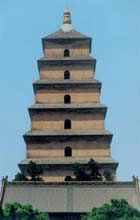
 The first contacts between adherents of Buddhism and the Chinese people took place along the Silk and Fur roads during the Eastern Han dynasty (8-220AD). Over subsequent centuries these central caravan routes, with Chang'an (near Xi'an) at their eastern terminus continued to serve as the principle avenue by which Buddhism entered China. So significant did this Indian religion become to Chang'an's development that by the eight century the city boasted sixty-four monasteries and twenty-seven nunneries, and had become a Buddhist centre of study for the East Asia region. As Buddhism was synthesized into Chinese thought, various new sects developed. One variant in particular, with Daoist influences, grew to prominence. This was Chan Buddhism. So influential did it become that Japanese monks transported it to their country where it became known as Zen Buddhism.
The first contacts between adherents of Buddhism and the Chinese people took place along the Silk and Fur roads during the Eastern Han dynasty (8-220AD). Over subsequent centuries these central caravan routes, with Chang'an (near Xi'an) at their eastern terminus continued to serve as the principle avenue by which Buddhism entered China. So significant did this Indian religion become to Chang'an's development that by the eight century the city boasted sixty-four monasteries and twenty-seven nunneries, and had become a Buddhist centre of study for the East Asia region. As Buddhism was synthesized into Chinese thought, various new sects developed. One variant in particular, with Daoist influences, grew to prominence. This was Chan Buddhism. So influential did it become that Japanese monks transported it to their country where it became known as Zen Buddhism.
The spectacular rise in popularity and wealth of the Buddhist institutions in China eventually incurred the Emperor's wrath. In 841 AD the insane, Daoist Emperor Tang Wuzong ordered a crackdown. During the next four years, nearly all Buddhist monasteries were decimated and its practitioners persecuted. Although many temples were refounded a few years later, Buddhism was never able to recover its former predominance in China's spiritual life.
The Big Goose Pagoda
This fine pagoda was built in honour of the work of Xuan Zang, the famous Chinese Buddhist monk, immortalized in the 16th century novel Journey to the West , otherwise known simply as, Monkey .
Born into a poor family, Xuan Zang became a monk at the age of eleven. By the time he was twenty-six, he'd grown so dissatisfied with poor translations of Buddhist works that he resolved to travel to India to discover uncorrupted Sanskrit texts. Since international travel was forbidden by the Emperor, Xuan Zang disguised himself and joined a group of Central Asian merchants heading West along the Silk Road. Seventeen years later in 645 AD, having travelled through sixteen countries, he returned to Chang'an. There he wrote the Record of the Western Regions , a detailed description of his travels which provided the authorities with up to date information about Central Asian countries. The Emperor authorized a translation of the new Sanskrit texts and constructed the Big Goose Pagoda, according to an Indian design, in which to store them.